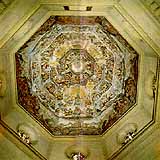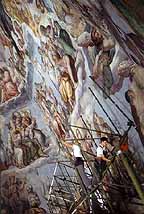
Vasari
Zuccari, frescoes in the Cupola
Excusez nous mais cette page n'est pas été encore traduite en Français
In 1572, Cosimo I de' Medici commissioned Giorgio Vasari to fresco the cupola of the Cathedral; he was flanked
by Don Vincenzo Borghini who worked out the iconographic subjects. The main
theme was based on the decisions that had emerged from the Council of Trent,
which had revised the mediaeval Catholic teachings and placed it in a clear
and systematic order. Borghini also added other themes taken from Dante's "Divine
Comedy", which he knew extremely well. The closest graphic text to
follow was based on the mosaics in the Baptistery, divided into rows placed one on top of the other,
though Vasari, a great admirer of Michelangelo, also drew inspiration from the Last
Judgement in the Sistine Chapel. As a result the space of the cupola (4.000
square metres) was further divided into six concentric rows placed one above
the other; carefully divided groups of figures were arranged inside each
of them, helped by the vault being in eight segments.
The subjects were carefully matched up along the the dividing lines (almost a
scansion into longitude and latitude), making it possible to "follow" the
theological pattern vertically as well as horizontally. Working from the top
to the bottom and starting from the imitation central lantern surrounded by 24
venerable old men from the Apocalipse, each segment is decorated with the four
following themes: an angelic chorus with the instruments of the Passion; a series
of Saints and Elect; a triad of figures representing a Gift of the Holy Ghost;
and a region of Hell dominated by deadly Sin. In the eastern segment, opposite
the centrale nave, the four rows become three to make room for the great Christ
in Glory between the Madonna and St. John, placed above the three Theological
Virtues (Faith, Hope and Charity), and followed further down by the allegorical
figures of Time and the Church Triumphant.

Giorgio Vasari,
Holy warrior
Vasari died however on June 27th 1574, after having carried out only a third of the work with the help of the Bolognese painter Lorenzo Sabatini. Vasari left the drawings for the four segments of the cupola which had not yet been painted and some sketches for the scenes from Hell to the Opera del Duomo. The death of the artist took place two months after that of his patron and the new sovereign, Francesco I de' Medici, decided to call in an artist from Urbino, Federico Zuccari, to complete the work.

Federico Zuccari, Self-portrait
Work started on the frescoes again on August 30th 1576. Zuccari, already
well known in Roman circles, did not particularly like Vasari's style and
tried, as much as he could, to affirm his own originality by renewing everything
that was not under Borghini's strict control. He stopped using Vasari's
method of "fresco" painting, preferring the
"dry" method (which was much simpler but far more delicate)
and changed the physiques of the painted characters, the costumes,
the stylistic language and the colour range. He boycotted the executive
delicacy that was so typical of Vasari (suble
colour changes, reflections, polished descriptions of ornaments),
which are difficult to pick out at such a distance, and opted for
a painting method that was weak in quality but of great effect, a
technique he had learned to use for display painting and theatrical
backcloths.
He portrayed a lively gallery of contemporary personalities among the Elect:
his Medici patrons, the Emperor, the King of France, Vasari,
Borghini, Giambologna and other artists, and even himself
and many of his friends and relations. As for the Christ in Glory, for which
Vasari had left drawings inspired by Michelangelo's
Sistine Chapel, Zuccari preferred to follow the models used by Raphael, which
were more in harmony with the sanctimonious rulings of the Council. However his
masterpiece in the cupola will always be his crude rendering
of Hell, with its powerful devils inspired by Luca Signorelli's frescoes in the
cathedral of Orvieto, the unrepentant bodies of the damned, violent gestures
and the red glow of blood that brings the dark colours of the composition to
vivid life.

Federico Zuccari, Hell
When he finally completed the frescoes in 1579, having also carried out several other interventions and changes on the parts painted by Vasari, Zuccari celebrated the event by preparing a commemorative medallion (today at the Bargello); this did not spare him from the criticism of the Florentines or satyrical madrigals by Lasca (Antonfrancesco Grazzini). The frescoes in the Cupola have never been popular in the city compared with their counterparts in the interior of the Cathedral: they are extremely difficult to look at because they are so far away from the viewer and placed in a dark spherical vault; it did not help when they were more and more obscured by the dirt of centuries.

Restoration of the frescoes
However they have since been scrupulously restored, a lengthy task that took from 1978 to 1985, and it is now possible to re-evaluate them, and appreciate the power of the cycle and its importance in Florentine art history. This enormous space made it possible to allow an interesting comparison between two different ways of understand*ing art, rather than antagonism between two painters: on the one hand, we have Vasari, a "conservative" painter and follower of a Tuscan tradition that had been passed down directly from the Middle Ages, on the other, Zuccari (with his helpers Stefano Pieri, Bartolomeo Carducci and Passignano), who "imported" the methods of the Roman painter-contractors to Florence, which were based on a poor executive quality but a grandiose final effect. This anticipated the future Roman Baroque style which was to influence Tuscan artists like Santi di Tito, another pioneer of the Counter Reformation.
